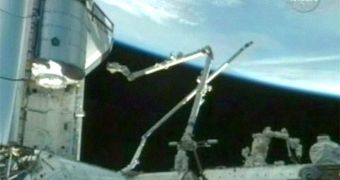Early this morning, April 8, the Multi-Purpose Logistics Module (MPLM) Leonardo was delivered to the International Space Station (ISS). The cargo module was attached to the NASA-built Harmony utility module at around 12:24 am EDT (04:24 GMT), after being removed from space shuttle Discovery's payload bay. The van-sized module MPLM was hoisted into place using the Canadian-built robotic arm aboard the orbital facility, Space reports.
The relocation of the module is crucial for the next stage of the plan, which seeks to transfer tens of tons of supplies, scientific equipments and food to and from the ISS. This type of mission needs to be very carefully choreographed, NASA experts say, as glitches could result in littering the exact same orbit in which the station is circling the Earth. If this happens, the facility could in the future be impacted by incoming debris. Given the speed at which this space junk moves, it could severely compromise the integrity of the lab, and even depressurize it altogether.
In charge of Leonardo's transfer were STS-131 mission specialists Stephanie Wilson (NASA) and Naoko Yamazaki (JAXA). The latter astronaut is her country's second female space flier, and also Discovery's cargo chief. This means that she will be in charge of the more than 120 hours of non-stop work that will see all of the cargo the shuttle carries being delivered to the station. Over the next nine days, this will be the primary task of the STS-131 mission, the NASA flight manifest shows. Once everything on Discovery is transferred, the module will again be filled with things that are no longer needed on the orbital facility.
The garbage will be returned to NASA aboard Discovery, once it heads home. The 6.4-meter-long module weights in excess of 13 tons, more than 7 of which are spare parts and equipment. During the shuttle's 13-day stay on the ISS, mission specialists Clayton C. Anderson and Rick Mastracchio will conduct three extra-vehicular activities (EVA), which will seek to replace an old ammonia tank on the exterior of the orbital lab with a new one, currently in the orbiter's payload bay. Discovery docked on the station yesterday morning, and is scheduled to return to Florida on April 18.

 14 DAY TRIAL //
14 DAY TRIAL //